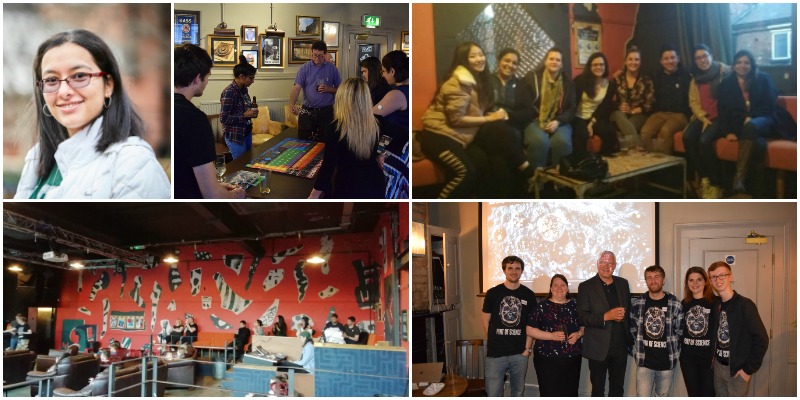University of Leeds takes part in Pint of Science festival 2019

Trying to recognize and understand the science behind nature mysteries or daily-life things that have impacts in our day-to-day issues and inspire challenging science questions, can be very fun when you learn about it and discuss it in a friendly atmosphere. That is the purpose of Pint of Science worldwide festival, to bring together researchers, students, and people interested in learning about flowers, nanoparticles, foam on your beer, the universe and anything else. Pint of science has grown every year and takes place in local pubs or cafes in different countries. This year nearly 400 cities of 24 countries hosted different events, and Leeds was one of the 41 UK cities where many different events where organized. We will share our experience in two events.
Living in a Material World
We had presentations from Dr. Nicole Hondow (Academic Fellow at the University of Leeds, an expert in materials characterization, electron microscopy, and nanoparticles) and Professor Cliff Jones (Professor of Soft Matter Physics group at the University of Leeds). Both shared their journey from students to highly recognized scientist, and the most recent findings of their research.
First, Dr. Hondow presented some general facts about her career and research. She highlighted that she can conduct high-technology research at the University of Leeds which has about £7 millions of equipment just in the school of Chemistry for studying different materials and share knowledge relevant to catalysis, medicine, toxicology, energy, the environment, physics, and other related subjects. She explained how nanoparticles can be sampled and studied using special equipment and learning to characterize the composition of different materials, including beer foam, smoke particles from biomass combustion, methane-oxidizing bacteria and, even spiders! No doubt that Dr. Hondow’s presentation was full of surprises, new knowledge, and inspiring life experiences.

Secondly, Dr. Jones also shared with us about his professional career and research findings. He started his talk by opening our eyes to the fact that there are not only three matter states, as we learned in primary school. Material studies on plasma, liquid crystals and condensates have allowed us to change our current lifestyles and has influenced all the technology we use: TV’s, mobiles, tablets, laptops and even contact lenses! Dr. Jones is also an entrepreneur that has founded two companies that continue to develop and promote new technologies associated with liquid crystals. His experience and talk were also very inspiring, and it was very nice to learn and understand such complex topics on a friendly informal atmosphere on this Pint of Science event.
Before the event and during the event we also had the chance to play some scientific games with the Periodic Table of the Elements, some models and matching pictures of nanoparticles to its name. Science is very fun!

The ducktor will see you now...
One of Leed’s events during the last day of Pint of Science festival was “The ducktor will see you now”, which took place in Belgrave Music Hall and Canteen. The first talked was given by Dr. Paul Thornton, an expert in polymers from the School of Chemistry, University of Leeds. His intervention transported us through the diverse usages of polymers in every day’s life as well as novel research. Over the last decades, the production of plastics has increased at a worrying speed. However, how bad can a polymer be to society? From tiny polyethylene, beads present in cosmetics and toothpaste and the polymers contained in reflux medicine, to the sugar cane based Legos and the use of chitosan on dye removal from wastewater polymers have merged and coexisted with humanity. In fact, polymers can enhance the quality of life not only by being introduced in play dough products or resistant suitcases but especially when applied in promising technologies such as drug delivery, for the treatment of several diseases.

After Dr. Thornton’s participation we had the chance to learn more about the behavior of some polymers by playing with some Play Dough (a starch-based solid product) and some powdered starch dissolved in water, and observing the behavior of Gaviscon (acid reflux medicine) as a dispersed and cross-linked polymer, under the presence of calcium and sodium chloride respectively. In another section of the pub, staff from the University of Leeds explained an introductory overview of liquid crystals and their behavior upon thermal changes.

The second presentation was introduced by Daniel Paterson (School of Physics and Astronomy), Dr. Jonathan Sandoe (School of Medicine), and Prof. Stephen Evans (School of Physics and Astronomy), from the University of Leeds. The issue of antimicrobial resistance was raised by Dr. Sandoe’s talk, in which a carbapenem-resistant E. coli and its multiple resistance mechanisms, were exemplified to address the relevance of this emerging topic. Then, Daniel Paterson explained the basics of liquid crystals, including their discovery in carrots, their liquid flow, and the relation between their specific order and the way they polarize light. Finally, Prof. Evans combined the previous talked, by presenting a biosensor based on lipid coated liquid crystal droplets. The principle of this method considered the orientation (radial or bipolar) acquired by the liquid crystals under the presence of a specific target (toxin, bacteria).

This was an opportunity to learn about interesting topics, but mostly, about current research that is taking place at different departments of the University of Leeds. We invite you to come to Leeds and be part of more events like this. You will surely enjoy your time in Leeds!
For more information visit:
https://pintofscience.co.uk/
@pintofscience
#pint19
